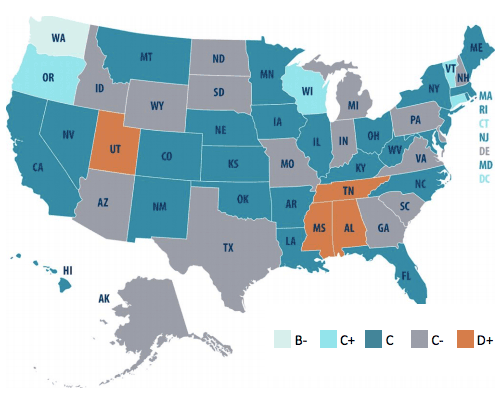
Click on the map to expand. Download the report to find out more details about your state's grade.
We called Shawn McMahon, the report’s author and acting director and CEO of WOW, to talk about how policy trends, the economic recovery and the sequester are affecting the economic security of Americans.
Theresa Riley: What are some of the policy areas that you looked at in your scorecard? How do you define economic security?
Shawn McMahon: Economic security, on the household level, is having the resources to meet basic needs — most simply stated as health, safety and basic economic participation, such as being able to work, access to banking, etc. — without public or private assistance.We first started to measure economic security — we originally called it self-sufficiency — in the 1990s during the welfare reform movement. At that time, the only measure of wellbeing available was the official federal poverty level. That measure, created in the 1960s, is very antiquated and it doesn’t tell us anything about people living $1 or $1,000 or $10,000 above the poverty line. It’s also not aspirational. It doesn’t tell us about the targets or the goals that we as a society (or the federal government) should have for people living under the federal poverty level.

Marjorie Hill, second left, CEO of the Gay Men's Health Crisis, address the Women for Paid Sick Days rally on the steps of New York's City Hall last summer. (AP Photo/Richard Drew)
Riley: Some have predicted that the growing number of female breadwinners will result in an increase in family friendly work policies, such as paid family leave and child care support for single mothers. Have you seen any evidence of this at the local level already? Do you agree that that’s likely?
McMahon: I do agree that it’s likely. Unfortunately, a lot of people consider these policies, or lack of policies, to be market phenomena. Although there are certainly groups here in D.C. and on the state level working hard to secure sick and safe days for workers, millions of whom lack them, I don’t think the average worker realizes that there is an option to press for this sort of benefit. Traditionally, a lot of these benefits would have been addressed by unions, and these days, with the lack of unions, a lot of workers simply consider themselves to be dependent upon their employer’s good will or at the mercy of the market.

Source: Living Below the Line: Economic Insecurity and America's Families, Wider Opportunities for Women
Riley: Can you talk about some states that are doing well in that area and what types of policies they’re implementing?
McMahon: There’s a wide range of policies that are affected at both the federal and the state level, and they play off of each other, such as the Family Medical Leave Act. It was created in 1993 to allow women leave in the event of a birth or to care for sick family members, but there were a lot of holes in the law. It only applied to establishments with 50 or more employees. It didn’t allow people to take leave to care for sick parents or elders. It also didn’t cover all employees. There’s a very long list of employee categories that are not covered by the law, so some states have taken the initiative in trying to expand the legislation, which makes up for some of these weaknesses.
To a large degree, that’s the nature of the relationship. For example, the state earned income tax credit or the caregiving credits are often expressed as percentages of the federal credit, or they’re intended to supplement that federal credit. Same thing for state minimum wage laws and many leave laws. A lot of public support programs at the state level are in some way either co-administered or based on what’s available at the federal level. So it’s rare that a state acts entirely independently of the federal laws, it tends to be responsive.
Riley: One thing I noticed in the report was the way that you highlighted state pre-K programs and enrollment not only as something beneficial for students in terms of education and job prospects, but in terms of the parents’ jobs, it also has to do with child care, right?
McMahon: Absolutely, and that’s a good example of something that’s determined at the state level, sometimes even the local level and less so at the federal level. The availability of preschool programs has been a major issue, and is becoming even more of an issue because research suggests that the earlier a student is enrolled in a school setting, the better their long-term outcomes; and secondly, with so many working parents, they want to have pre-school available to them, not only as a way of defraying costs, but also to make sure that their children are in a proper setting.
For a lot of low or moderate income families getting quality, licensed child care is a stretch. For some, it’s only a dream. The availability of a quality program for their kids is very important. States need to think about these [programs] not just as an expense, but as an investment, in that these several investments are interlocking and interdependent.
Surprisingly, some of the states that are not highly ranked did better in the education category than we might otherwise expect. States like Alabama and Arkansas seem to be investing more heavily than some other states in the aforementioned preschool opportunities, and we may see those types of investments paying off down the road in a way that we don’t see it at the moment.
Riley: What were some other findings that surprised you?
McMahon: We didn’t find there was much of a relationship between the state’s fiscal health, in recent years, and whether or not they received higher overall grades on their economic security related policies. Every year each state spends billions of dollars, perhaps a bit less in smaller states. The solution to improving economic security is not necessarily for states create a large number of new laws or a large number of very expensive programs. Instead, they need to take this comprehensive view of economic security and use it as something of a checklist or a blueprint, and determine where the money is best spent, and then create policies to plug very definitive holes in the overall scheme.
Riley: What about federal budgets? Does sequestration have any effect on these policies or programs?
McMahon: For better or worse, the sequester rarely eliminates or nullifies a policy or a program. Rather, it tends to trim or substantially cut the budgets of a lot of these programs, so that wouldn’t necessarily affect a lot of the scores in a lot of the categories that we looked at, but it would certainly affect variables such as spending per capita, in certain areas. We know that states are, for example, cutting a lot of family friendly policies, such as the number of preschool slots available, the number of child care subsidies available and the amounts of subsidies, the investment in their workforce system, thereby decreasing the number of people that could be trained or retrained by the state workforce development system. And as everybody knows intuitively, this will have a cumulative impact in the long run, when these lack of investments don’t pay off or come back to our detriment.


